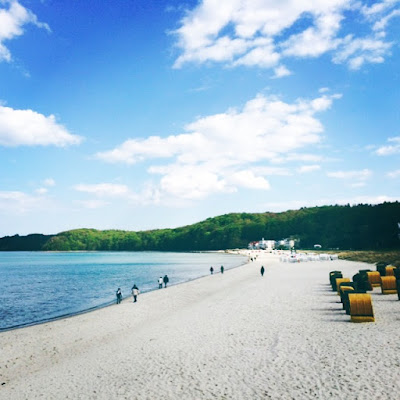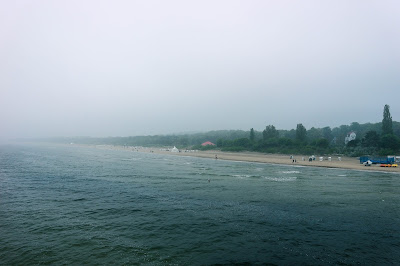The 3 Best Beaches on Germany's Baltic Sea Coast
Are you looking for the perfect place to cool down in the stifling summer heat?
As the weather becomes warmer, it has almost became a tradition for people to descend en masse to the beach. Whether it's just a trip to the local beach (that is, if you're lucky enough to be living near one), or even a full-fledged getaway to the world's most famous beaches like the Kuta Beach in Bali.
For the last 2 years, I have been exceptionally lucky to be studying in a city located directly by the Baltic Sea. Living along the coast of the Baltic Sea also offers me an opportunity to explore multiple beaches, and this post, I am going to list down three of the best ones in Germany's West Pomerania area for you to put on your travel list.
If you're looking for the perfect combination of nature and history, a trip to Binz will be just what the doctor ordered. Binz's strategic location allow visitors to explore Germany's smallest national park of Jasmund in Sassnitz, home to Germany's highest chalk cliff dubbed "Königsstuhl", which is a mere half an hour ride away. You can also hop on a bus to the next town of Prora, a town with a massive 4,5 kilometers long building complex built by Nazi Germany in 1936-1939 planned to be the Third Reich's ultimate resort, to get a dose of history.
Of course, you can always lounge along Binz's pristine beaches. With is powder-fine white sand, picturesque Strandkorb, Baltic Sea's signature shallow waters, and the classic American South colonial buildings in the background, there's hardly any better setting for a beach vacation.
On the german side, Usedom has multiple resort towns, amongst which are Seebad Bansin, Heringsdorf, and Ahlbeck. Visitors can take the regional trains or drive by car to access the different resort towns, but walking through the streets along the coast offers a scenic view as well as opportunities to come across interesting sites.
Along the beach promenade of Heringsdorf you will found high end hotels and restaurants developed from converted grand mansions, as well as many Ferienwohnungen (holiday houses) built in the colonial style of the American south, much like those that can be found in Binz.
The varying seaside resort towns along the island offers visitors multiple unique experiences in a relatively small space. Be relaxed at Bansin, shop and dine at Heringsdorf, and try out the Freie Körper Kultur at Ahlbeck. However, don't forget to explore each of the town's Seebrücke (sea bridge) for the signature picture of the Baltic Sea Beaches.
Rent a caravan and drive up north to Loissin, a small village near the Bay of Greifswald. Loissin has a dedicated space for those who has brought their caravans, the so-called "Campingplatz"or "camping space". It is also a popular spot for those who do kitesurfing, as the strong winds of the Baltic Sea and the shallow waters allow for a relatively safe experience.
As the weather becomes warmer, it has almost became a tradition for people to descend en masse to the beach. Whether it's just a trip to the local beach (that is, if you're lucky enough to be living near one), or even a full-fledged getaway to the world's most famous beaches like the Kuta Beach in Bali.
For the last 2 years, I have been exceptionally lucky to be studying in a city located directly by the Baltic Sea. Living along the coast of the Baltic Sea also offers me an opportunity to explore multiple beaches, and this post, I am going to list down three of the best ones in Germany's West Pomerania area for you to put on your travel list.
1. Ostseebad Binz
Located on the eastern coast of Germany's biggest island of Rugia (Rügen), the seaside resort town of Binz is one of the most popular holiday destination in north Germany. |
| Ostseebad Binz |
If you're looking for the perfect combination of nature and history, a trip to Binz will be just what the doctor ordered. Binz's strategic location allow visitors to explore Germany's smallest national park of Jasmund in Sassnitz, home to Germany's highest chalk cliff dubbed "Königsstuhl", which is a mere half an hour ride away. You can also hop on a bus to the next town of Prora, a town with a massive 4,5 kilometers long building complex built by Nazi Germany in 1936-1939 planned to be the Third Reich's ultimate resort, to get a dose of history.
Of course, you can always lounge along Binz's pristine beaches. With is powder-fine white sand, picturesque Strandkorb, Baltic Sea's signature shallow waters, and the classic American South colonial buildings in the background, there's hardly any better setting for a beach vacation.
How to get to Ostseebad Binz from Berlin:
The Island of Rugia is accessible by car and train through bridges that connects the island with mainland Europe via the city of Stralsund.- By train : Take the regional train of RE3 (Line : Eberswalde-Stralsund) from Berlin Hauptbahnhof (Berlin Main Station) to Stralsund Hauptbahnhof and change trains to RE9 (Line : Stralsund-Sassnitz), stepping off at the Station Ostseebad Binz
- By car : Take the A11 and A20 to Stralsund and continue on the B196 to Binz.
2. Insel Usedom
Germany's second largest island, located on the southern side of the Baltic Sea, is the ultimate recreation space. Whilst most of the island counts as german territory, about 20% of the eastern side of the island belongs to Poland, along with the its largest city of Świnoujście. |
| Heringsdorf |
 |
| The mansion along Heringsdorf's beach promenade |
On the german side, Usedom has multiple resort towns, amongst which are Seebad Bansin, Heringsdorf, and Ahlbeck. Visitors can take the regional trains or drive by car to access the different resort towns, but walking through the streets along the coast offers a scenic view as well as opportunities to come across interesting sites.
Along the beach promenade of Heringsdorf you will found high end hotels and restaurants developed from converted grand mansions, as well as many Ferienwohnungen (holiday houses) built in the colonial style of the American south, much like those that can be found in Binz.
The varying seaside resort towns along the island offers visitors multiple unique experiences in a relatively small space. Be relaxed at Bansin, shop and dine at Heringsdorf, and try out the Freie Körper Kultur at Ahlbeck. However, don't forget to explore each of the town's Seebrücke (sea bridge) for the signature picture of the Baltic Sea Beaches.
How to get to Usedom from Berlin:
The Island of Rugia is accessible by car and train through bridges that connects the island with mainland Europe via the city of Wolgast and Murchin (car only).- By train : Take the regional train of RE3 (Line : Eberswalde-Stralsund) from Berlin Hauptbahnhof (Berlin Main Station) to the station of Züssow and change trains to RB23 (Line : Stralsund-Świnoujście Centrum), stepping off at the respective station of Seebad Bansin, Heringsdorf or Ahlbeck.
- By car : Take the A11 and A20 to Pasewalk and continue on the B109 and B110 to Usedom.
3. Loissin
If all you want to do is to escape the hectic city life, indulge in on of germans' favourite holiday style : camping.
 |
| Loissin Beach, a popular spot for kitesurfing |
 |
| Loissin Beach, with the distant view of Insel Rügen |
Rent a caravan and drive up north to Loissin, a small village near the Bay of Greifswald. Loissin has a dedicated space for those who has brought their caravans, the so-called "Campingplatz"or "camping space". It is also a popular spot for those who do kitesurfing, as the strong winds of the Baltic Sea and the shallow waters allow for a relatively safe experience.
For over a kilometre, the depth of the waters gradually increases up to a metre and a half, with much of it only reaching a metre deep, allowing parents with a small peace of mind when allowing their children to play in the water.
Loissin is a great place for relaxing or even just to hang out and barbecue with friends, as I have done myself on multiple occasions. And even though Loissin is small, the view from its beach is incredible, with the vague shape of the Rügen ahead, and the outline of the city of Greifswald to its left.
How to get to Loissin from Berlin:
There are no direct train connection to Loissin, and the nearest bus stop is at least 2,5 km away from the beach. I would advise making the trip with a car.- By public transportation : Take the regional train of RE3 (Line : Eberswalde-Stralsund) from Berlin Hauptbahnhof (Berlin Main Station) to the station of Greifswald and continue with the Bus 137, stepping off at the bus stop of Loissin.
- By car : Take the A11 and A20 to Gützkow and continue on the B11 and B109 to Loissin.
The Baltic Sea offers a multitude of beaches which caters to every need. And what's better than the cooling sea water when the summer heat wave sweeps in?
xo,
Maria







No comments: